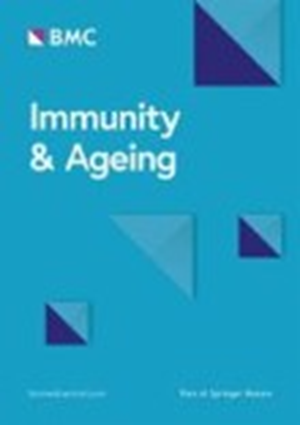The effect of metformin on senescence of T lymphocytes
IF 5.2
2区 医学
Q1 GERIATRICS & GERONTOLOGY
引用次数: 0
Abstract
Immunosenescence occurs as people age, leading to an increased incidence of age-related diseases. The number of senescent T cells also rises with age. T cell senescence and immune response dysfunction can result in a decline in immune function, especially in anti-tumor immune responses. Metformin has been shown to have various beneficial effects on health, such as lowering blood sugar levels, reducing the risk of cancer development, and slowing down the aging process. However, the immunomodulatory effects of metformin on senescent T cells still need to be investigated. PBMCs isolation from different age population (n = 88); Flow Cytometry is applied to determine the phenotypic characterization of senescent T lymphocytes; intracellular staining is applied to determine the function of senescent T cells; Enzyme-Linked Immunosorbent Assay (ELISA) is employed to test the telomerase concentration. The RNA-seq analysis of gene expression associated with T cell senescence. The middle-aged group had the highest proportion of senescent T cells. We found that metformin could decrease the number of CD8 + senescent T cells. Metformin affects the secretion of SASP, inhibiting the secretion of IFN-γ in CD8 + senescent T cells. Furthermore, metformin treatment restrained the production of the proinflammatory cytokine IL-6 in lymphocytes. Metformin had minimal effects on Granzyme B secretion in senescent T cells, but it promoted the production of TNF-α in senescent T cells. Additionally, metformin increased the concentration of telomerase and the frequency of undifferentiated T cells. The results of RNA-seq showed that metformin promoted the expression of genes related to stemness and telomerase activity, while inhibiting the expression of DNA damage-associated genes. Our findings reveal that metformin could inhibit T cell senescence in terms of cell number, effector function, telomerase content and gene expression in middle-aged individuals, which may serve as a promising approach for preventing age-related diseases in this population.二甲双胍对 T 淋巴细胞衰老的影响
免疫衰老会随着年龄的增长而发生,导致老年相关疾病的发病率增加。衰老 T 细胞的数量也随着年龄的增长而增加。T细胞衰老和免疫反应功能障碍会导致免疫功能下降,尤其是抗肿瘤免疫反应。二甲双胍已被证明对健康有多种益处,如降低血糖水平、减少癌症发病风险和延缓衰老过程。然而,二甲双胍对衰老T细胞的免疫调节作用仍有待研究。从不同年龄人群(n = 88)中分离 PBMCs;采用流式细胞术确定衰老 T 淋巴细胞的表型特征;采用细胞内染色法确定衰老 T 细胞的功能;采用酶联免疫吸附试验(ELISA)检测端粒酶浓度。对与T细胞衰老相关的基因表达进行RNA-seq分析。中年组的衰老T细胞比例最高。我们发现二甲双胍能减少CD8 +衰老T细胞的数量。二甲双胍会影响 SASP 的分泌,抑制 CD8 + 衰老 T 细胞 IFN-γ 的分泌。此外,二甲双胍还能抑制淋巴细胞中促炎细胞因子 IL-6 的产生。二甲双胍对衰老 T 细胞中 Granzyme B 的分泌影响甚微,但却能促进衰老 T 细胞中 TNF-α 的产生。此外,二甲双胍还能增加端粒酶的浓度和未分化T细胞的频率。RNA-seq结果显示,二甲双胍促进了与干性和端粒酶活性相关的基因的表达,同时抑制了DNA损伤相关基因的表达。我们的研究结果表明,二甲双胍可以从细胞数量、效应功能、端粒酶含量和基因表达等方面抑制中年人T细胞的衰老,这可能是预防中年人群中与年龄相关疾病的一种有前景的方法。
本文章由计算机程序翻译,如有差异,请以英文原文为准。
求助全文
约1分钟内获得全文
求助全文
来源期刊

Immunity & Ageing
GERIATRICS & GERONTOLOGY-IMMUNOLOGY
CiteScore
10.20
自引率
3.80%
发文量
55
期刊介绍:
Immunity & Ageing is a specialist open access journal that was first published in 2004. The journal focuses on the impact of ageing on immune systems, the influence of aged immune systems on organismal well-being and longevity, age-associated diseases with immune etiology, and potential immune interventions to increase health span. All articles published in Immunity & Ageing are indexed in the following databases: Biological Abstracts, BIOSIS, CAS, Citebase, DOAJ, Embase, Google Scholar, Journal Citation Reports/Science Edition, OAIster, PubMed, PubMed Central, Science Citation Index Expanded, SCImago, Scopus, SOCOLAR, and Zetoc.
 求助内容:
求助内容: 应助结果提醒方式:
应助结果提醒方式:


